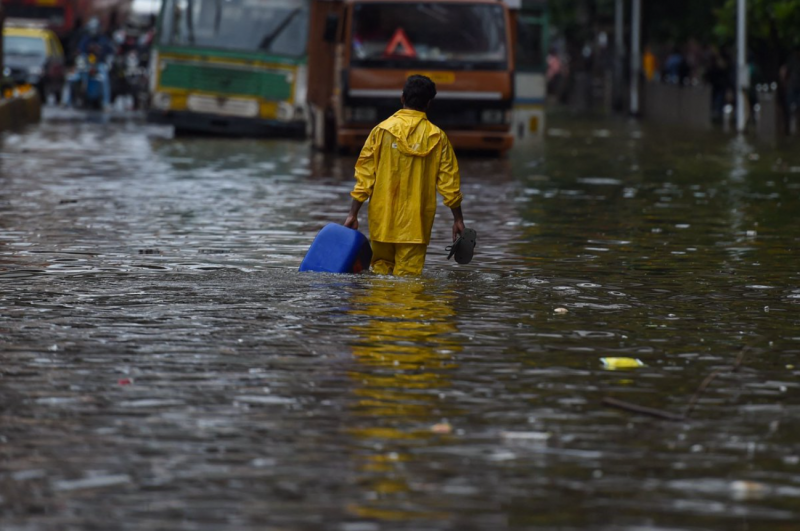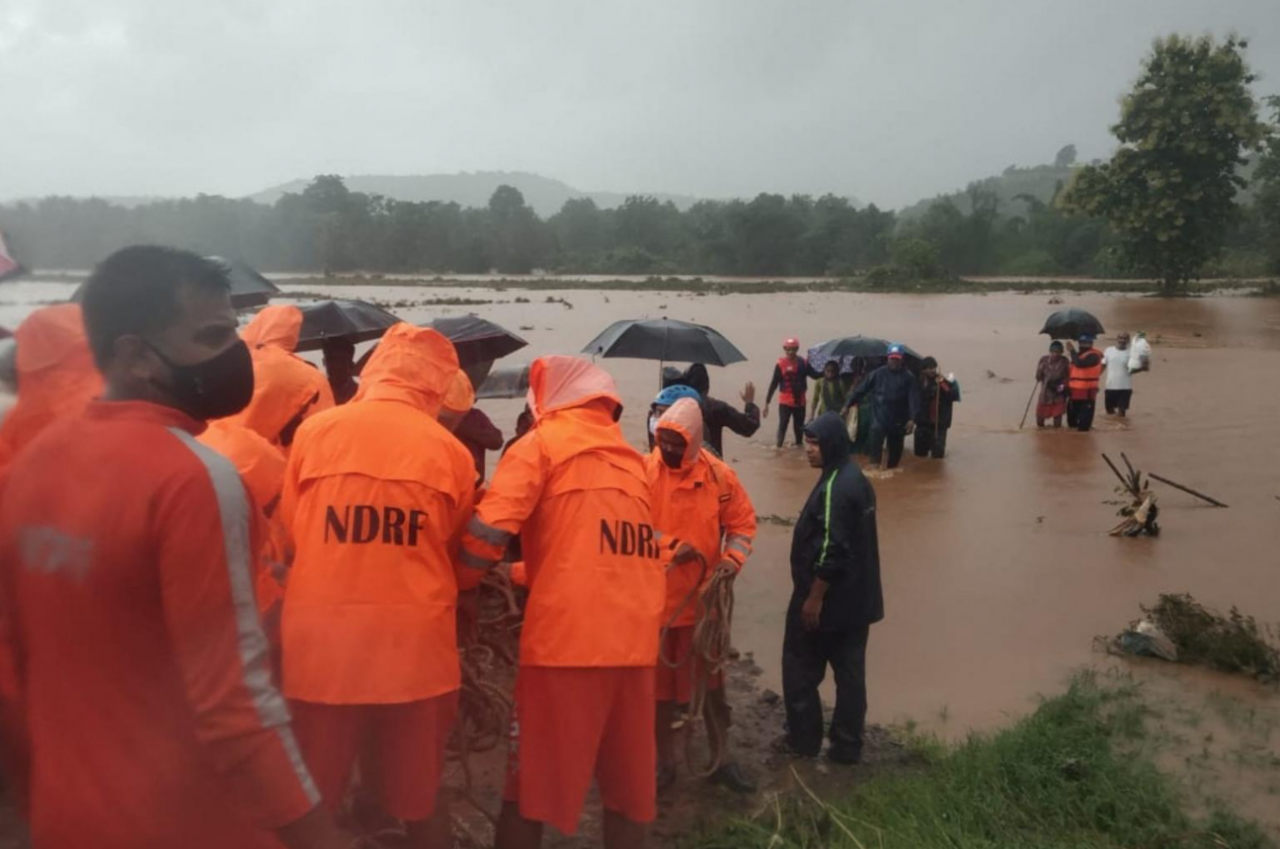India issues red alert after 136 die following heavy rain
State govt confirms over 84,000 people rescued; similar weather predicted in next few days

Torrential downpours have lashed the western coast of India in recent days, leaving dozens missing. – AFP pic, July 24, 2021
NEW DELHI – Several Indian states, including Goa, Maharashtra, Karnataka and Tamil Nadu, have reported floods and landslides following incessant rain over the past 48 hours, reported Sputnik news agency.
The India Meteorological Department (IMD) has also predicted similar weather for the next few days.
At least 136 people have died due to heavy rain in Maharashtra in the last 48 hours, Maharashtra Relief and Rehabilitation Minister Vijay Wadettiwar told reporters.
Late last night, the state government confirmed that over 84,000 people have been rescued.
Ratnagiri is the worst-hit district, where eight Covid-19 patients at a hospital died when water entered the premises. A total of 38 individuals were also found dead in the coastal areas of the district, and 50 others are still trapped in Talai village due to a landslide.
NEW DELHI – Several Indian states, including Goa, Maharashtra, Karnataka and Tamil Nadu, have reported floods and landslides following incessant rain over the past 48 hours, reported Sputnik news agency.
The India Meteorological Department (IMD) has also predicted similar weather for the next few days.
At least 136 people have died due to heavy rain in Maharashtra in the last 48 hours, Maharashtra Relief and Rehabilitation Minister Vijay Wadettiwar told reporters.
Late last night, the state government confirmed that over 84,000 people have been rescued.
Ratnagiri is the worst-hit district, where eight Covid-19 patients at a hospital died when water entered the premises. A total of 38 individuals were also found dead in the coastal areas of the district, and 50 others are still trapped in Talai village due to a landslide.

NRDF personnel rescuing stranded villagers from flooded low-lying areas following heavy rains in Chiplun, Maharashtra. – AFP pic, July 24, 2021
The rain caused worry in hundreds of villages, sweeping away houses and leaving residents stranded.
National Disaster Response Force and Indian Army Rescue personnel are evacuating survivors, but many people are feared missing.
The Maharashtra government has announced an ex gratia of US$6,717 (RM28,389) to each family whose members have died in landslides triggered by heavy rain in different parts of the state.
The situation is worrying in neighbouring states, too. Several parts of Goa, including Sattari and Bicholim in the north and Dharbandora in the south, are facing a flood-like situation.
In Karnataka, three people have died due to heavy rainfall. About 9,000 others have been evacuated after landslides occurred in eight places in the state.
IMD yesterday issued a red alert informing state authorities to “take action”, an orange alert to “stay prepared” and a yellow alert to “be aware”. – Bernama, July 24, 2021
The rain caused worry in hundreds of villages, sweeping away houses and leaving residents stranded.
National Disaster Response Force and Indian Army Rescue personnel are evacuating survivors, but many people are feared missing.
The Maharashtra government has announced an ex gratia of US$6,717 (RM28,389) to each family whose members have died in landslides triggered by heavy rain in different parts of the state.
The situation is worrying in neighbouring states, too. Several parts of Goa, including Sattari and Bicholim in the north and Dharbandora in the south, are facing a flood-like situation.
In Karnataka, three people have died due to heavy rainfall. About 9,000 others have been evacuated after landslides occurred in eight places in the state.
IMD yesterday issued a red alert informing state authorities to “take action”, an orange alert to “stay prepared” and a yellow alert to “be aware”. – Bernama, July 24, 2021
Bullyland built four times more dams than Yindia to control annual floods but the result is FAILURE. Now they want to build another HUGE one in Tibet.....now we know why they annexed Tibet 70 years ago.
ReplyDeleteQUOTE
Al Jazeera
By Oliver Lees
8 Feb 2021
In the foothills of the Himalayas, where the ancient Yarlung civilisation established the first Tibetan Empire, China has plans to build the world’s biggest hydroelectric dam.
In November of last year, China’s state-owned media shared plans for a 60-gigawatt mega-dam on the Yarlung Tsangpo river in the Tibetan Autonomous Region (TAR).
Now with the aim of achieving carbon neutrality by 2060, Beijing has redoubled its efforts on its hydropower projects in Tibet, even though the dams have drawn criticism from Tibetan rights groups and environmentalists...
The Yarlung Tsangpo is of particular significance, as it represents the body of the goddess Dorje Phagmo, one of the highest incarnations in Tibetan culture.
....But since China, controlled by the Communist Party (CCP), annexed Tibet in 1950, Zamlha says Tibetans have lost all say in what happens on their land.
“We had absolutely no dams before Chinese occupation, not because we were not able to harness it, but because we had immense respect for the nature of the rivers,” he told Al Jazeera.
“There’s a very strict tradition that no one will go near certain streams or do anything that would disturb it. You don’t even need laws – every Tibetan abides by it.
“The Chinese will do anything to benefit their growth and this is very frustrating because Tibetans are not consulted.”
From its origin in the glaciers of western Tibet, the Yarlung Tsangpo reaches heights of nearly 5,000 metres (16,404 feet) above sea level, making it the highest river in the world as it snakes its way through the Himalayan mountain range.
The river plunges 2,700 metres (8,858 feet) through what is known as the Yarlung Tsangpo Grand Canyon, forming a gorge more than twice the depth of the Grand Canyon in the United States.
The precipitous fall makes it particularly conducive to collecting hydroelectric power but experts have warned the record-breaking dam is likely to have political and environmental consequences.
According to the Power Construction Corp of China’s chairman, Yan Zhiyong, the mega-dam’s has primarily been constructed to power China’s green future.
While China already has an excess of energy, Brian Eyler, an expert in rivers who is the director of the South East Asia Program at the Stimson Center, says the power generated will probably be used to cover losses as it makes the transition from fossil fuels to cleaner energy.
The mega-dam could produce as much as three times the hydroelectric power of China’s current largest dam, the Three Gorges, a project which forced the relocation of more than 1.4 million people.
But there is a precedent for the relocation of the local residents to make way for dam projects on the Yarlung Tsangpo, with local media reporting nearly 2,000 people were moved for the construction of the Yagen Hydropower Station in 2015.
Zamlha believes Tibet’s resources such as the Yarlung Tsangpo and Mekong rivers were a key factor in the CCP’s decision to take control of Tibet more than 70 years ago.
After leaving China, the Yarlung Tsangpo flows into Bangladesh and the Indian states of Arunachal Pradesh and Assam, where the river is referred to as the Brahmaputra.
With the proposed mega-dam sited just 30 kilometres (18 miles) from the Indian border, Zamlha believes the CCP will “definitely try to use it as a political tool”.
A spokesperson for India’s ministry in charge of managing its water resources said it would respond with a 10-gigawatt project on another tributary of the Brahmaputra.
The Yarlung Zangbo flows into India where it is known as the Brahmaputra and supports thousands of fishing communities along its banks.
UNQUOTE
Wakakakakaka…
DeleteU indeed have a shameless desire to parade yr know nothingness!
This piece of cesspool concentrate is a model of trash for those who know the FACT!
Keep to yr c&p, u do need the exercise to spark yr boring life. Otherwise, u would die standing.
Arab malay islam death rate is also flooding the kampung....disproportionate malay islam death is appropriate when you have population explosion and glorify your race and religion....Rahmat al-lah berpatutan hapuskan AGENDA RACIS AWAK!!
ReplyDeleteAn unique comparison between capitalism & socialism based on natural disasters that has raised new insights about supply&demand dogma of the marketing economy.
ReplyDeleteIn February 2021, the state of Texas suffered a major power crisis, which came about as a result of three severe winter storms sweeping across the United States on February 10–11, 13–17 and 15–20; a massive electricity generation failure in the state of Texas; and resultant shortages of water, food, and heat. More than 4.5 million homes and businesses were left without power, some for several days. At least 210 people were killed directly or indirectly, with some estimates as high as 700 killed as a result of the crisis.
From July 19-24 2021, Zhengzhou (pop 5.51M) in China suffered a massive torrential downfall that resulted in devastating floods. Many areas, within the surrounding urban & rural, were facing electricity, communication, foods&water shortages. So far 58 people have been confirmed dead with 5 missing.
During the the Texas crisis, many local commercial items saw the prices sky rocketed. In Austin (pop 2.11M) electricity was priced at the extremely high wholesale prices ($9,000/MWh, typically $50/MWh) on to consumers. Many items in the supermarkets were emptied even though the prices were raised. Many of the deads were caused by hypothermia (no heating) & carbon monoxide poisoning (burning of coals).
This is a very typical marketing economy based on the capitalistic supply&demand model. Supply bottlenecks raise the demand prices!
In the Zhengzhou crisis, the socialistic supply&demand marketing influences were heading in the opposite direction.
Many hotels lowered their room rates to ridiculous level just to house those displaced people. Many restaurants were given out free meals to whoever that's hungry. Even the telecommunication link was temporally restored via a flying drone encircling the affected city.
Supply bottlenecks reduce the demand prices!
What gives?
Which marketing matrices holds the truth?
Or is there more to material gains in supply&demand curve that the western economists have been postulated?